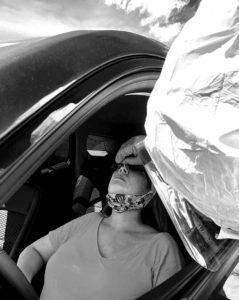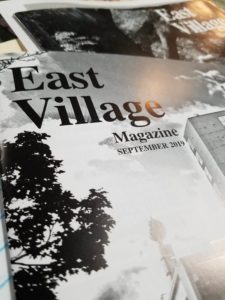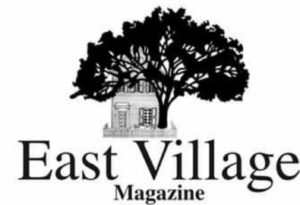By Paul Rozycki
It’s been two years.
March 10, 2020. That was the day when Michigan saw its first two COVID cases. Ironically, it was also an election day, and the beginning of the widespread shutdown of much public activity in the state.
Within days, colleges and K-12 schools were closed to in-person learning. Bars, restaurants, gyms, and factories shut down, and emergency restrictions were imposed on many public gatherings in the following weeks. By early April, there were over 20,000 COVID cases in Michigan, and nearly 1000 deaths.

COVID-19 testing in the City of Flint during the summer of 2020. Photo by Tom Travis)
At first, we thought it would be over in a month or so. Then we expected things would ‘return to normal’ after a year. Now, two years later, we are again hopefully looking to the end of the COVID pandemic, yet nothing seems to be ‘back to normal.’
Will there be another variant? Will there be another spike in infections? Will we need a fourth booster shot?
How have we been changed?
After two years, how have we all been changed by COVID? The list is long, and it will take years to sort it all out, but at every level, it’s a different world today than it was two years ago, in both big and small ways.
The medical system’s response
On the national level we’ve seen the American medical system respond quickly with vaccines that limit the spread of COVID and prevent infection. Yet, we’ve also seen bitter battles and partisan conflicts over actually getting the shots, leaving many vulnerable.

McLaren Hospital sign lights up just at dusk as the neighbors in near by homes show solidarity with their life saving work during the coronavirus pandemic. (Photo by Tom Travis)
We’ve also seen American hospitals and medical personnel, often touted as the best in the world, overwhelmed by the numbers of those infected by the COVID virus. Yet, in spite of it all, they rose to meet the challenge.
Zoom meetings
We’ve learned of the virtues and vices of working at home, and Zoom meetings. Many workers now expect to spend at least a good part of their working time at home, rather than commuting to an office.

7th Circuit Court Judge Celleste Bell’s courtroom broadcast on YouTube. Seen in the picture are a view of the courtroom with the Judge, ACLU Attorney Alec Gibbs and City Attorney Angela Wheeler. The other views on the screen are ACLU attorneys. (Screenshot from YouTube submitted by Tom Travis)
Yet, for all its convenience, a Zoom meeting isn’t quite the same as meeting someone in person. Will the home office be standard in the future? Almost certainly, the workplace will be quite different in the years to come.
Who are the essential workers?
We’ve also discovered those who are the most essential workers. Obviously they are the doctors, nurses, county public health workers, and other medical professionals who face COVID every day. But so are the store clerks, waitresses, janitors, teachers, bus drivers, postal workers, journalists, police officers, and fire fighters, who deal with the public every day. Hedge fund managers probably didn’t make the list.

Flint Police Officers gathered for a press conference at City Hall in September 2020. (Photo by Tom Travis)
The shutdowns and upheaval caused by COVID has also led many workers to leave their current jobs, and pursue new work opportunities. Most business now post help wanted signs on their front door, promising higher wages and benefits.
Supply chain shortages
We’ve become accustomed to shortages of toilet paper, hand soap, meats, pet food, new and used cars, and computer chips, among many other products. We often go to the grocery store with the hope that we will find what we need.
We’ve learned how critical the ‘supply chain’ is to keeping the store shelves full of the goods we have always expected to find there.
COVID’s partisan divisions
We’ve also seen how COVID, which is a threat to everyone, and should have united us, has become another point of partisan conflict. Wearing a mask has become a way to tell one’s partisan leanings.
The vaccination rates between Republicans and Democrats are dramatically different. Even what were once routine local school board meetings have become shouting matches over mask mandates and virtual learning.

Michigan Governor Gretchen Whitmer speaking to the press at Flint’s Hamilton Community Health Clinic in late February 2020. (Photo by Tom Travis)
In Michigan, some of those opposed to Gov. Whitmer’s strong response to COVID threatened to kidnap her, and hold her for trial. Yet, for the Flint City Council, both COVID and a recent election seem to have had little effect.
Whether they were held virtually or in person, the meetings still seem to go on endlessly, fueled by personal attacks, racial division, and bickering.
What it means for East Village Magazine
For those of us who are part of East Village Magazine COVID has given us some serious challenges as well. At a time when newspapers and magazines are disappearing around the country, community journalism is more critical than ever, and EVM is working hard to fill that role.
At a time when democracy is under pressure, it’s more important than ever to have coverage of local government and community events to keep the First Amendment and democracy alive and well.

East Village Magazine cover from September 2019. (Photo by Tom Travis)
Our December/January issue was delayed by paper shortages caused by supply chain problems. We have now learned that Riegle Press, who has been our printer for more than 20 years, is ceasing production, and we have the challenge of finding a new printer who can deliver the quality that Riegle did, at a similar price, and a similar time frame.
So far, from all estimates, the cost of printing will be higher, and that may result in either fewer copies of EVM to distribute, fewer pages in each issue, or something other than a monthly publication schedule.
Our second challenge is people. If most other business are posting help wanted signs, we are no different. As a semi-volunteer organization, with modest pay for staff, we need reporters, writers, distributors, advertising people, and business help. If you have skills in any of those areas, and an interest in keeping local journalism alive and well in Flint, let us know.
And, of course, funding is critical to all that we do. Currently EVM is funded by a grant from the Mott Foundation, advertising revenue, and supporters from the community who are committed to keeping the East Village Magazine alive and well.

Even as COVID has placed new demands on funding from all sources, East Village Magazine appreciates all the help and support we have received from the Flint community.
Even with all these challenges, we expect to continue to tell Flint’s story, as we have since 1976, long before anyone heard of COVID.

EVM Political commentator Paul Rozycki
EVM political commentator Paul Rozycki can be reached at Paul.Rozycki@mcc.edu.


You must be logged in to post a comment.